Senate Democratic Caucus
This article needs additional citations for verification. (November 2020) |
Senate Democratic Caucus | |
|---|---|
 | |
| Part of | United States Senate |
| Chair and Floor Leader | Chuck Schumer (NY) |
| Floor Whip | Dick Durbin (IL) |
| Assistant Leader | Patty Murray (WA) |
| Vice Chairs | Mark Warner (VA) Elizabeth Warren (MA) |
| Ideology | Centrism Modern liberalism Progressivism |
| Political position | Center to center-left[1] |
| Affiliation | Democratic Party |
| Colors | Blue |
| Seats | 50 / 100 |
| Website | |
| democrats.senate.gov | |
| |
| This article is part of a series on the |
| United States Senate |
|---|
 |
| History of the United States Senate |
| Members |
|
| Politics and procedure |
|
| Places |
|
The Democratic Caucus of the United States Senate, sometimes referred to as the Democratic Conference, is the formal organization of all senators who are part of the Democratic Party in the United States Senate. For the makeup of the 117th Congress, the caucus additionally includes two independent senators (Bernie Sanders of Vermont and Angus King of Maine) who caucus with the Democrats, bringing the current total to 50 members. The central organizational front for Democrats in the Senate, its primary function is communicating the party's message to all of its members under a single banner.
Current leadership[]
Effective with the start of the 116th Congress, the conference leadership is as follows:
- Caucus Chair: Senate Majority Leader Chuck Schumer (New York)
- Senate Majority Whip: Dick Durbin (Illinois)
- Assistant Leader: Patty Murray (Washington)
- Caucus Vice Chairs: Mark Warner (Virginia) and Elizabeth Warren (Massachusetts)
- Policy Committee Chair: Debbie Stabenow (Michigan)
- Steering Committee Chair: Amy Klobuchar (Minnesota)
- Outreach Chair: Bernie Sanders (Vermont)
- Policy Committee Vice Chair: Joe Manchin (West Virginia)
- Caucus Secretary: Tammy Baldwin (Wisconsin)
- Campaign Committee Chair: Gary Peters (Michigan)
- Chief Deputy Whip: Jeff Merkley (Oregon)
- President pro tempore: Patrick Leahy (Vermont)
History[]
The conference was formally organized on March 6, 1903, electing a chair to preside over its members and a secretary to keep minutes. Until that time, this caucus was often disorganized, philosophically divided and had neither firm written rules of governance nor a clear mission.
Chairs[]
Since Oscar Underwood's election in 1920, the chair of the Senate Democratic Caucus has also concurrently served as the floor leader as part of an unwritten tradition.
| Senator | State | Term of office | Congress | |||
|---|---|---|---|---|---|---|
| Start | End | Length | ||||
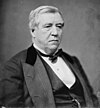
|
John W. Stevenson | Kentucky | December 1873 | March 4, 1877 | 3 years | 43rd → 44th |

|
William A. Wallace | Pennsylvania | March 4, 1877 | March 4, 1881 | 4 years, 0 days | 45th → 46th |

|
George H. Pendleton | Ohio | March 4, 1881 | March 4, 1885 | 4 years, 0 days | 47th → 48th |
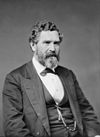
|
James B. Beck | Kentucky | March 4, 1885 | May 3, 1890 | 5 years, 60 days | 49th → 51st |

|
Arthur Gorman | Maryland | May 3, 1890 | April 1898 | 7 years | 51st → 55th |

|
David Turpie | Indiana | April 1898 | March 4, 1899 | 0 years | 55th → 55th |

|
James Kimbrough Jones | Arkansas | December 1899 | March 4, 1903 | 3 years | 56th → 57th |

|
Arthur Gorman | Maryland | March 4, 1903 | June 4, 1906 | 3 years, 92 days | 58th → 59th |
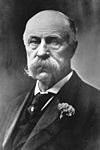
|
Joseph Blackburn | Kentucky | June 4, 1906 | March 4, 1907 | 273 days | 59th → 59th |

|
Charles Culberson | Texas | December 1907 | December 1909 | 1–2 years | 60th → 61st |

|
Hernando Money | Mississippi | December 1909 | March 4, 1911 | 1 years | 61st → 61st |
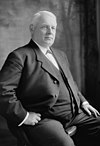
|
Thomas S. Martin | Virginia | April 1911 | March 4, 1913 | 1 years | 62nd → 62nd |
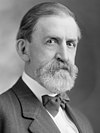
|
John W. Kern | Indiana | March 4, 1913 | March 4, 1917 | 4 years, 0 days | 63rd → 64th |

|
Thomas S. Martin | Virginia | March 4, 1917 | November 12, 1919 | 2 years, 253 days | 65th → 66th |

|
Gilbert Hitchcock (acting) | Nebraska | November 12, 1919 | April 27, 1920 | 167 days | 66th → 66th |

|
Oscar Underwood | Alabama | April 27, 1920 | December 3, 1923 | 3 years, 220 days | 66th → 68th |

|
Joe Robinson | Arkansas | December 3, 1923 | July 14, 1937 | 13 years, 223 days | 68th → 75th |

|
Alben W. Barkley | Kentucky | July 14, 1937 | January 3, 1949 | 11 years, 173 days | 75th → 80th |
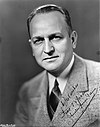
|
Scott W. Lucas | Illinois | January 3, 1949 | January 3, 1951 | 2 years, 0 days | 81st → 81st |
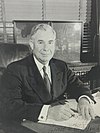
|
Ernest McFarland | Arizona | January 3, 1951 | January 3, 1953 | 2 years, 0 days | 82nd → 82nd |
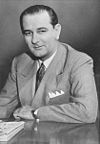
|
Lyndon Johnson | Texas | January 3, 1953 | January 3, 1961 | 8 years, 0 days | 83rd → 86th |

|
Mike Mansfield | Montana | January 3, 1961 | January 3, 1977 | 16 years, 0 days | 87th → 94th |

|
Robert Byrd | West Virginia | January 3, 1977 | January 3, 1989 | 12 years, 0 days | 95th → 100th |
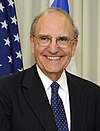
|
George J. Mitchell | Maine | January 3, 1989 | January 3, 1995 | 6 years, 0 days | 101st → 103rd |

|
Tom Daschle | South Dakota | January 3, 1995 | January 3, 2005 | 10 years, 0 days | 104th → 108th |

|
Harry Reid | Nevada | January 3, 2005 | January 3, 2017 | 12 years, 0 days | 109th → 114th |

|
Chuck Schumer | New York | January 3, 2017 | Incumbent | 4 years, 251 days | 115th → |
Vice chair[]
After the victory of Democrats in the midterm elections of 2006, an overwhelming majority in the conference wanted to reward Chuck Schumer, then the chair of the Democratic Senatorial Campaign Committee, with a position in the leadership hierarchy.[citation needed] In response, then-Democratic Leader Harry Reid created the position of vice-chair when Democrats formally took control in 2007.[2] Schumer ascended to Reid's position following his retirement after the 2016 elections. The position was then split, with one co-chair awarded to Mark Warner and the other awarded to Elizabeth Warren.
- Chuck Schumer (2007–2017)
- Mark Warner and Elizabeth Warren (2017–present)
Caucus secretary[]
The United States Senate Democratic Conference Secretary, also called the Caucus Secretary was previously considered the number-three position, behind the party's floor leader and the party's whip, until in 2006, when Democratic leader Harry Reid created the new position of Vice-Chairman of the caucus. Now, the secretary is the fourth-highest ranking position. The conference secretary is responsible for taking notes and aiding the party leadership when senators of the party meet or caucus together.[3]
The first conference secretary was Sen. Edward W. Carmack of Tennessee, who was elected in March 1903.[4]
The current conference secretary is Sen. Tammy Baldwin of Wisconsin, who assumed the office in January 2017.
| Officeholder | State | Term |
|---|---|---|
| Edward W. Carmack | Tennessee | 1903–1907 |
| Robert Owen | Oklahoma | 1907–1911 |
| William E. Chilton | West Va. | 1911–1913 |
| Willard Saulsbury Jr. | Delaware | 1913–1916 |
| Key Pittman Acting |
Nevada | 1916–1917 |
| William H. King | Utah | 1917–1927 |
| Hugo Black | Alabama | 1927–1937 |
| Joshua B. Lee | Oklahoma | 1937–1943 |
| Francis T. Maloney | Connecticut | 1943–1945 |
| Brien McMahon | Connecticut | 1945–1952 |
| Thomas Hennings | Missouri | 1953–1960 |
| George Smathers | Florida | 1960–1966 |
| Robert Byrd | West Va. | 1967–1971 |
| Ted Moss | Utah | 1971–1977 |
| Daniel Inouye | Hawaii | 1977–1989 |
| David Pryor | Arkansas | 1989–1995 |
| Barbara Mikulski | Maryland | 1995–2005 |
| Debbie Stabenow | Michigan | 2005–2007 |
| Patty Murray | Washington | 2007–2017 |
| Tammy Baldwin | Wisconsin | 2017–present |
References[]
- ^ https://fivethirtyeight.com/features/the-six-wings-of-the-democratic-party/. Retrieved 15 July 2021. Missing or empty
|title=(help) - ^ Bolton, Alexander (January 20, 2021). "Schumer becomes new Senate majority leader". The Hill. Retrieved January 23, 2021.
- ^ "Conference Secretaries". U.S. Senate.
- ^ "Senate Democratic Caucus Organized". U.S. Senate.
Bibliography[]
- Donald A. Ritchie (ed) (1999). Minutes of the Senate Democratic Conference: Fifty-eighth through Eighty-eighth Congress, 1903-1964. Washington, D.C. GPO. Available online in PDF or text format.
External links[]
- Official Home of the Senate Democratic Caucus on the Internet
- Senate Party Leadership – much of this article's content was adapted from this useful public domain resource
- First Formal Organization of the Senate Democratic Caucus
| show |
|---|
- Democratic Party (United States) organizations
- Leaders of the United States Senate
- United States Senate
- Lists related to the United States Senate